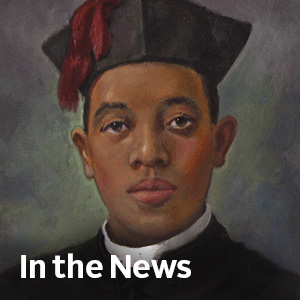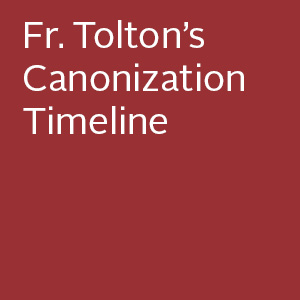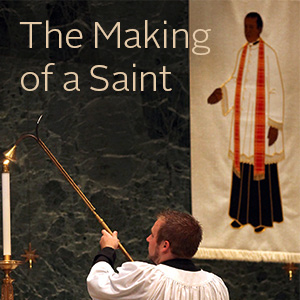Biography
Father Augustus Tolton
1854 – 1897
Saints arise from the exigencies of the eras within which they live. Saints are of human stock but have the genius to step forward and bring the gospel message to the contradictions of their time. In the case of Augustus Tolton it is the long period of black slavery in this country and the nation’s Civil War foisting a resolution to uncompensated black servitude and the tumultuous period of Reconstruction of a nation torn to shreds over this issue. Augustus witnessed mistreatment of his people and became a victim himself of such mistreatment.
Without a national program to assist the assimilation of freed slaves into the fabric of the country, its schools, social and educational institutions and politics were found generally off limits to blacks especially where whites were invested. What Tolton experienced in that time of social ambivalence is stuff we read about in history books or view in certain documentaries.
A nation experimenting with democracy and certain notions of freedom was unable to process the dignity of black skin amidst the kaleidoscope of ethnic diversity emerging therein. Tolton’s earliest schooling was interrupted by the protests of his peers and adults or while having to work as a laborer in bottling and saddle making factories and as a church janitor to help his mother support their family. Religiously inclined in his boyhood, nurtured by promptings of his mother Martha, he was found spending hours in church in prayer in between job schedules. He attended out of-the-way classes taught by friendly priests and nuns who saw in his eyes the bright spark of the love of God, a tender devotion to the Church and a determination to serve people whether black or white.
As a teenager he taught religion classes to black children of Quincy, Illinois. Refused seminary training in this country because of his race, these same sympathetic priests and nuns helped him to receive a proper education and eventually seminary formation in Rome.
Although the Venerable Augustus Tolton lived over a hundred years ago his spirituality still speaks to us with incredible clarity and inspirational vitality for our times.
In the 1880s, a black man becoming a priest was thought to be impossible and, in fact, might never have been set in motion were there not a few priests and religious of courageous, visionary and unselfish choices made by them; Fathers Peter McGirr and Theodore Wegmann, School Sister of Notre Dame Herlinde Sick, Franciscan Fathers Michael Richardt and Francis Ostrop who were some of the best representatives of Catholics in action for their time. They leave us with good thoughts and smiles on our faces; each of them with a strong sense of justice pushing critically through the moral and ethical paradoxes of those times; each of them unafraid to permit their pastoral efforts to be reflective of their views and values. They knew the odds that stood against them and the Church. Their efforts were remarkable in face of those odds and likely those odds could have proven too high to overcome. Many others thought so:
Following the required six years of study, Augustus was ordained a priest with his class Easter Vigil 24 April 1886 at St. John Lateran Basilica in Rome.
“It was said that I would be the only priest of my race in America and would not likely succeed,” Tolton once wrote. But a Cardinal, Giovanni Simeoni in Rome said, “America has been called the most enlightened nation; we'll see if it deserves that honor. If America has never seen a black priest it has to see one now!” With these prophetic words the assignment orders for Father Tolton changed from some place in Africa back to Quincy, Illinois in the Diocese of Alton.
Augustus Tolton is a pioneer African American Catholic who was not only the first priest of acknowledged African descent to serve anywhere in the United States but one who navigated the choppy waters of racial acceptance endemic to 19th century America and modeled for us how to be Christians amidst the social inconsistencies of that former time with his faith, hope and love found in the end to be intact. He showed himself a priest-servant to both black and white at a time when it was not socially appropriate or lawful to do so. His modeling shows us how to witness to the Gospel in midst of racial tension and instances of racial hatred that erupt still from time to time.
We have seen over the many years a variety of ways to confront the evil of racism, social protest violent and non-violent, academically through oratory, literature, prose and story-telling. The Gospel offers one approach, one that enjoins loving our enemies, doing good to those who mistreat us, approaching every man, woman and child out of genuine respect, honoring their dignity as a human being and as fellow brother and sister in Christ. Father Tolton modeled all this in its fullness and this is why he is remembered to this day especially in the black Catholic community.
Father Tolton shows us in his own life’s pattern that we can find blessing in everything, even what is most painful. His story is one of suffering service. Through his experiences of racial negation by a society that would separate black and white by force of the law and lawless custom, Tolton found the love of God, found his own vocation and ultimately has received his reward from God as a figure of Christian faith in action, indiscriminate love of neighbor and pastoral charity despite the bigotry that was thrown at him.
The record of his life is absent any show of retaliation toward anyone or anything. Mild mannered and self-effacing as he was, Father Tolton survived enormous odds during that particularly difficult period of US history that viewed him an anomaly as an achieving black man, former slave and Catholic priest. Tolton, rather, shows us how to wrestle through fear, hurt and disappointment and see these experiences through the prism of the Lord’s own suffering to redeem a people.
A gentleness of spirit best describes his personality in such wise that the inquirer cannot detect any irritability in him. Tolton always showed himself refined maintained undoubtedly by a great fortitude of spirit within. Nonetheless, as detected in his handwritten letters to personages and church authority figures, he felt keenly the humiliations inflicted by others, that underneath he felt deeply the sting of verbal assaults and impatience others threw at him, the harshness and humiliations inflicted upon him, and he felt deeply the indignities and insults his people suffered. Forces attempted to derail his priestly service in a creeping milieu of diversity that cried out for social and legal recognition but for which society and church could not respond at that time.
We find no evidence of outburst in him in face of what he endured. He lived the Gospel within adversity and he did so faithfully for his entire life in a simple and loving way. He maintained above all fortitude of spirit harboring no resentment for any of the insults and offenses receive from others.
Tolton’s life story inserts a dialectic into a begrudging situation of intransigence to social and moral change. He had his moments of self-doubt and stark loneliness that in retrospect took their toll on his emotional and physical well-being.
His kind-heartedness, no doubt, was derived from certain innate virtues of his person and his friendship with God. Father Tolton could find joy under trial and be himself simultaneously an encourager of others with their trials. We presented to the Church Tolton as a model Christian and priest during a time of paradox, an era of social deficits that attempted to derail his priestly ministry. He faced opposition notably from within the Christian community, the one institution he should have been able to rely upon for compassion and support. The 19th century, with its many church denominations, aligned itself with the prevailing mood of the time. Blacks were considered inferior and were begrudgingly accepted, if at all, in the social groupings and institutions that made up America. Being the first black Catholic priest he was thrust as the first in a long line of black leaders who summoned the Church to embrace its black brothers and sisters.
We are inspired by Tolton’s courage and innocent determination in face of incredible race prejudice typical of that bygone era but for which we now take as a source of inspiration for the work that remains in the 21st century.
That passage from the letter to the Hebrews must have resonated in Tolton’s heart:
“Recall the days gone by when, after you had been enlightened, you endured a great contest of suffering. At times you were publicly exposed to insult and trial; at other times you associated yourselves with those who were being so dealt with … do not, then surrender your confidence; it will have great reward. You need patience to do God’s will and receive what he has promised.” [10, 32-33; 35-36]
Tolton’s legacy says to us that transformation is possible through suffering. His journey of deliverance from slavery and discrimination offers potent imagery for anyone who finds inspiration from his life when suffering persecution because of one’s faith or one’s race.
His beatification we hope will provide renewed impetus within the African American Catholic community in the United States; as one of our own being raised to mention at the altar will send a spiritual recharge to the hope of African American Catholics that we need at this time and have needed for quite some time. His canonization we hope will elicit an appreciation by the wider Catholic community for the contributions that Catholics of African descent offer the Church. Tolton is a model of virtue for all Catholics.
The Witness of Suffering
It is not easy reasoning to the place of suffering in the human journey. On the other hand, Christians worship a suffering Messiah and so have theologized about this conundrum over the course of two thousand years and counting. Yet, essentially, the results of this struggled reasoning are pretty much the same for us as they are for anyone else regardless of faith perspective or lack thereof. Suffering can result in strengthened faith or disbelief, agnosticism or outright atheism. Not till Judgment Day will we have an answer to the why of black suffering and black ignominy, or dare we say, Black Holocaust? We gaze at the crucifix to find a source of meaning. The crucifixion of Jesus reminds us that black suffering is a means through which God has loved his dark children. We cannot know the Christ unless we know him crucified, says St. Paul. And somehow and in some way our historic suffering must benefit or have benefited some body, some cause, only God knows.
Saints and mystics have left us a legacy of their life’s pattern with some glimpse into the mystery. But, there are no clear answers at this time. In the meantime, we look to the scriptures to find inspiration for our Christian lifestyle in the choices we make, solutions to problems and to simply live each day’s challenges. We also find inspiration in the lives of those who live that gospel with heroic seriousness and who model for us Christ like disposition and behavior.
Father Tolton was demeaned for reasons of his race and background. It was the way he handled this challenge to his Christian faith that presents him remarkable and therefore a model for how we can handle protracted disappointment, and seeming hopelessness. The word “no” was spat in Tolton’s face more often than not because of his skin color. He was called some pretty nasty names. In that social inequities remain apparent in our times Tolton offers strident Christians a model of deportment that is useful in what it can mean for the reconciliation of the races.
God must be watching to what has happened to Jews, African Americans, Native Americans, indeed anyone and everyone who has sought freedom, be they white, black or brown, this side of the world to over on the other side of the world. The world is filled with suffering peoples. God must be working salvation out through it all while none of it makes sense. What message is God sending through repeated instances of human agony and crucifixion?
The world is saved ultimately by our being victims. And we each participate in this unfortunate victimization in varying degrees. This victimization is placed on the altar of worship daily through the lives of people all over. It is a haunting theme that runs through the Christian story, an indelible line in the Christian narrative, an interestingly powerful story that has as its banner, the cross.
Jesus saved the world precisely as a victim not as a celebrity or military general. Worship at the altar is always a commemoration of Jesus Christ as victim. Standing at the altar the priest talks to God in conversation about his only begotten Son’s victimization so that sins may be forgiven. We believers try to make sense of our own experiences of being victims along life’s way by gazing back at what happened to the Savior in his own mistreatment. Jesus experienced the worse that a man could deal out to another and, therefore, leaves us an example. Shockingly, as we turn the page of the sacred story we find a new chapter unguessed and unforeseen: God forgave us even after what we did to his Son. It is precisely this point where Easter faith begins. The story starts there at Calvary. It takes a strong person of faith to place their suffering on the paten and in the chalice of the sacrifice we offer each day.
Why Declare Him a Saint
Father Tolton is a saint for doing things priests do, namely, care for people, ministering to their desperate needs, anointing them with the saving graces of the sacraments, forgiving their sins, preaching a word that works to transform the Church to its more authentic face before the world and describe for people how they can give an authentic response to God in genuine discipleship. But Father Tolton received no rewards or citations in life. Society and the Church did not allow Tolton to do these priestly things so easily assigned to him. He suffered genuinely in that these priestly things were administered from a black face, black hands and a black heart. 19th century America placed dark skin at the bottom of the color pyramid. This has become, unfortunately, an indelible stigma in the American psyche. Even certain scripture passages were manipulated to justify people of African descent as preordained by God for perpetual servitude and haphazard treatment, thereupon, blackness dismissed as a universal symbol of inferiority.
Tolton, a man of deep feeling, viewed himself a priest for anyone and everyone who approached the Church for the grace and mercy of God. But society could not perceive nor accept that he was a priest for both black and white. Facets of the Church coopted what society legislated by norm and practiced by lawless custom as regards the races. Throughout, Tolton remained steady in his ministry thinking only the best about everyone, with a resolve to labor in a pastoral situation that would offer hope to a people, poor people, any people.
His was a quiet approach, a novel ministry to black and white together and he was, unfortunately, resented for it. People were unable to see the evangelical side to this novel situation of a black priest and the advantages it afforded church and society. He had every reason to become embittered. But bitterness was alien to Tolton’s soul. Instead, gratitude moved him through to victory. His temperament allowed him to rejoice in the Lord while under trial. He could smile to the world while suffering; his gentle spirit essentially emanating from an inner disposition of goodness.
God pulled him through a sinful situation. Gratitude to a few priests and religious who tutored him and advocated to have him recognized for his goodness; gratitude that moved him to declare the Catholic Church the principle instrument of improvement of the plight of the black race.
Tolton’s sanctity emerges from an experience of the cross. His goodness easily elicits our affection and our empathy, a goodness that attracted people of whatever background to his sermons and ministrations and counsel. He was a bright light in a dark time.
The touching story of Augustus Tolton reminds us of the glaring social deficits of a former time. Much has improved since that time but much still remains to be done to build on a society that can be an emblem of interracial peace. Here and there we are stunned by incidents of intolerance and racial hatred in places. A religious figure like Tolton arises with unique inspiration amidst the chasms that remain apparent between black and white races in this country.
The good Lord allowed his witness only a short stay here. Tolton reminds us of the courage we have within our hearts to continue to work for racial and ethnic solidarity while eradicating all forms of hesitancy and intolerances.
- Bishop Joseph N Perry





